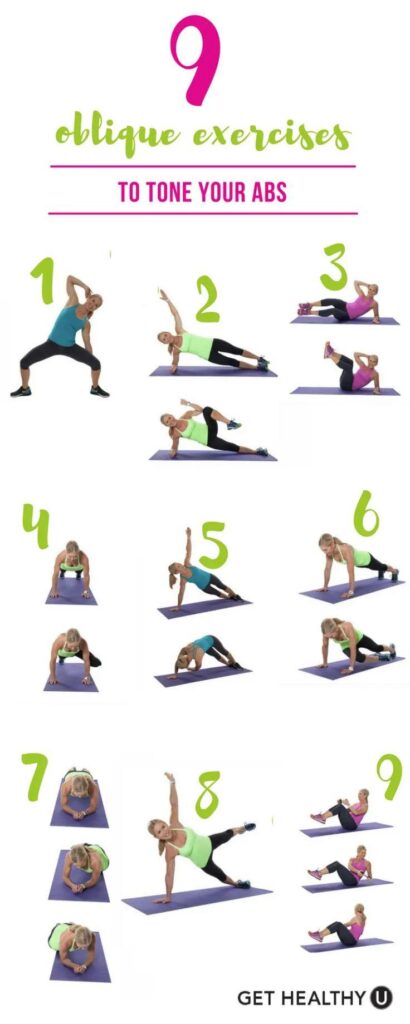when it comes to building a strong, resilient core, many fitness enthusiasts focus primarily on customary exercises like crunches and planks. However, neglecting the obliques—the muscles running along the sides of your abdomen—can limit your overall core strength and stability. Effective oblique workouts are essential not only for sculpting a defined waistline but also for improving posture, enhancing athletic performance, and preventing injuries. In this article, we will explore targeted oblique exercises that go beyond the basics, helping you develop a balanced and powerful core foundation. Weather you’re a beginner or looking to take your regimen to the next level, these strategies will empower you to strengthen your obliques safely and efficiently.
Table of Contents
- Understanding the Role of Obliques in Core Strength and Stability
- Anatomy and Function of the Oblique Muscles Explained
- Top Oblique Exercises for Building Strength and Improving Balance
- Incorporating Oblique Workouts into a Comprehensive Core Training Routine
- To Wrap It Up
Understanding the Role of Obliques in Core Strength and Stability
the obliques are critical for maintaining core strength and overall stability. Positioned on the sides of your abdomen, these muscles contribute to vital movements like twisting, bending sideways, and stabilizing the spine during dynamic activities.When properly engaged,they support posture,reduce the risk of injury,and enhance athletic performance by transferring power efficiently between the upper and lower body.
Incorporating oblique exercises into your routine is essential for balanced core growth. Focusing on these muscles helps in improving rotation and lateral flexion, key elements in many functional movements and sports. Benefits of strong obliques include:
- Better balance and coordination
- Increased power during rotational movements
- Reduced lower back pain through improved spinal support
- Enhanced posture and core endurance
Ignoring oblique training can lead to muscular imbalances, which compromise the integrity of the entire core unit and limit performance. Prioritize targeted workouts to unlock the full potential of your core.
Anatomy and Function of the Oblique Muscles Explained
The oblique muscles, comprising the external obliques and internal obliques, play a crucial role in core dynamics. Located on the sides of the abdomen, these muscles twist the torso and stabilize the spine during movement. The external obliques sit superficially and run diagonally downward, enabling rotational movements, while the internal obliques lie beneath, running at right angles and assisting with side bending and rotation.Together, they form a vital part of the abdominal wall, supporting posture and protecting visceral organs.
Their primary function extends beyond mere movement, as they contribute substantially to spinal stability and breathing mechanics.activation of the obliques enhances intra-abdominal pressure, supporting the lumbar spine and reducing injury risk during heavy lifting or sudden twists. Key roles include:
- Facilitating trunk rotation and lateral flexion
- Assisting in forced expiration by compressing the abdominal cavity
- Providing dynamic support during complex athletic movements
Understanding these essential functions can guide targeted workouts that build a stronger, more resilient core.
Top Oblique Exercises for Building Strength and Improving Balance
Targeting the obliques effectively requires exercises that not only focus on muscle activation but also enhance overall functional balance. Movements such as Russian twists, side planks with hip dips, and standing cable woodchoppers engage the oblique muscles dynamically, promoting both strength and stability. These workouts challenge your core in rotational and lateral planes, crucial for improving posture and preventing injuries related to muscular imbalances. Incorporating resistance or weights exponentially increases the intensity, making these exercises vital for anyone serious about core conditioning.
Beyond direct oblique engagement, integrating exercises that demand balance underpins long-term progress. The obliques play a pivotal role in stabilizing the torso during uneven or lateral movements, which means including unilateral exercises like single-arm farmer’s carries and side plank reaches can expand muscle endurance and improve neuromuscular control. This comprehensive approach not only enhances muscular definition but solidifies your foundation for advanced athletic performance and daily functional activities.
Incorporating Oblique Workouts into a Comprehensive Core Training Routine
Balancing oblique exercises with overall core training is essential for developing a well-rounded and functional midsection. The obliques play a critical role in rotational movements and lateral stability, which means they should be integrated thoughtfully alongside exercises targeting the rectus abdominis and transverse abdominis. To construct an effective routine, pair dynamic oblique moves like cable woodchoppers or side planks with foundational core stabilization exercises such as planks, dead bugs, and bird dogs. This approach not only enhances muscle symmetry but also reduces the risk of imbalances that could lead to injury or compromised posture.
Consistency and progression are key when embedding oblique workouts into your regimen. Start with controlled, bodyweight variations before advancing to weighted or resistance-based movements for increased challenge. Incorporate variations that activate both the internal and external obliques to stimulate comprehensive development. Keep these points in mind:
- Focus on quality over quantity: Prioritize form and controlled motion to maximize effectiveness and prevent strain.
- Include unilateral exercises: Movements like side planks with leg lifts help isolate and strengthen each side independently.
- Vary movement planes: Combine rotational, lateral flexion, and anti-rotational exercises to cover all functional aspects.
- Integrate recovery sessions: Allow adequate rest to support muscle repair and growth within your comprehensive schedule.
To Wrap It Up
Incorporating effective oblique workouts into your fitness routine is essential for building a strong, stable core that supports both everyday movements and athletic performance.By focusing on targeted exercises that engage these often-overlooked muscles, you can enhance your overall balance, improve posture, and reduce the risk of injury. remember, consistency and proper form are key to unlocking the full benefits of oblique training.Commit to these strategies, listen to your body, and gradually challenge yourself to achieve lasting core strength and stability. Your efforts today will pave the way for a healthier, stronger tomorrow.

